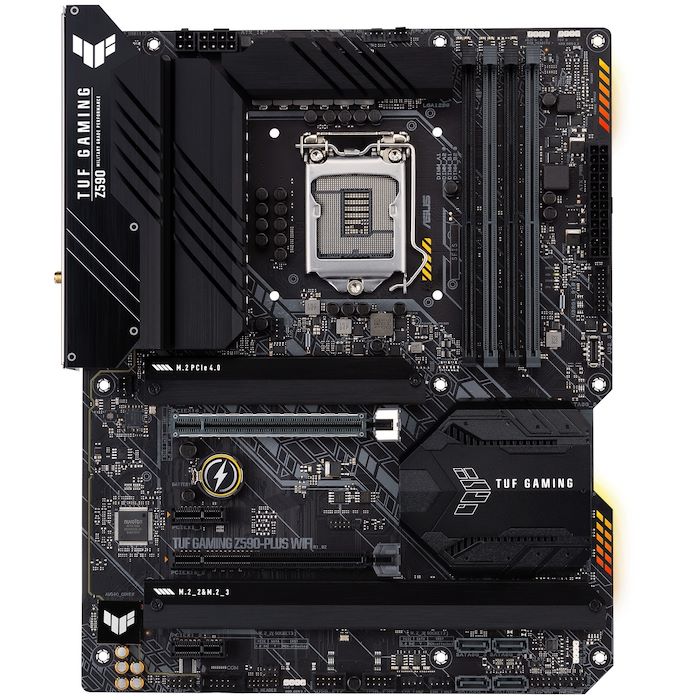The Intel Z590 Motherboard Overview: 50+ Motherboards Detailed
by Gavin Bonshor on January 19, 2021 10:15 AM ESTASUS TUF Gaming Z590-Plus & Z590-Plus WIFI
The Ultimate Force, or known as TUF, used to be a premium focal point of ASUS's motherboard range built on durability and when it used to have a better-than-standard warranty and full body armor. However over the last couple of years the brand has shifted somewhat as the ASUS TUF series now represents its entry-level gaming options. ASUS is advertising a 14+2 phase power delivery, with one 8-pin and 4-pin 12 ATX CPU power input pairing, three M.2 slots, and Intel 2.5 GbE and Wi-Fi 6 networking. The only difference between the two Z590-Plus and Z590-Plus WIFI is the latter is using a wireless CNVi module. Everything else is identical.
The ASUS TUF Gaming Z590-Plus WIFI includes two full-length PCIe slots, one PCIe 4.0 x16, another at PCIe 3.0 x4, with two PCIe 3.0 x1 slots. It includes three M.2 slots, one with PCIe 4.0 x4, and two PCIe 3.0/SATA, and includes six SATA ports with support for RAID 0, 1, 5, and 10 arrays. ASUS includes support DDR4-4800 memory, with four available slots that can accommodate up to 128 GB.
Looking at the rear panel, ASUS includes one USB 3.2 G2 Type-C, two USB 3.2 G2 Type-A, two USB 3.2 G1 Type-A, and two USB 2.0 ports. It's using Intel's I225-V 2.5 GbE controller and includes an Intel AX200 Wi-Fi 6 CNVi, supporting BT 5.0 devices. For users looking to use Intel's integrated graphics, there's a DisplayPort and HDMI video output, with a PS/2 combo port, and five 3.5 mm and S/PDIF optical output powered by a Realtek S1200A HD audio codec.
When ASUS rebranded The Ultimate Force (TUF) series from a robust series focused on reliability and toughness to its entry-level gaming series, the price being touted for the ASUS TUF Gaming Z590-Plus WIFI is $306, which is certainly not entry-level pricing. This is due to various premium controllers, albeit well used, including an Intel 2.5 GbE and Wi-Fi 6 pairing. There is a non WIFI version with a slightly lower price tag of $290.












88 Comments
View All Comments
Oxford Guy - Tuesday, January 19, 2021 - link
You’ll never be able to block all the spyware with a firewall. Windows is just one component of it. Don’t forget things like stealth CPUs that are built into the CPU, like the little friend on Lando’s shoulder. Etc.lmcd - Tuesday, January 19, 2021 - link
What, the tinfoil hat isn't enough anymore? The "spyware" is just as present on any Windows era.If you want to disable built in telemetry, pay for pro and disable it in the registry. It's not hard if you're really that into privacy.
Spunjji - Wednesday, January 20, 2021 - link
@lmcd - but that would require *effort* - why waste that effort on customising a modern OS, when he could expend more effort cobbling together a barely-working platform on a 12-year-old one? 😂Makaveli - Wednesday, January 20, 2021 - link
lol all I saw in my head reading those post are "old man yells at clouds"Oxford Guy - Friday, January 22, 2021 - link
That’s due to the fact that the old man has just as much chance of getting the spyware out of Windows and CPUs (and the rest) as you lot have a chance of saying something relevant.Oxford Guy - Friday, January 22, 2021 - link
Call us when the shuttle lands, Pauline.Slash3 - Tuesday, January 19, 2021 - link
Z590 only provides six native SATA ports.ASRock's Z590 Taichi has eight ports, with two via an ASMedia ASM1061 controller.
Silver5urfer - Wednesday, January 20, 2021 - link
Got it thanks. I suppose that's how the EVGA Dark got it's 8 SATA ports too.weilin - Thursday, April 29, 2021 - link
Z590, if i remember correctly... has 30 HSIO lanes total:6 of which are dedicated to USB (and can be ganged in pairs for 20Gb/s ports)
4 more that is either USB 10Gb/s or 5Gb/s or PCIe.
2 of them which can be Ethernet or PCIe,
2 of them which can be SATA, Ethernet, or PCIe.
6 of them which can be SATA or PCIe.
10 dedicated PCIe
So everything all together means theoretically maximum of:
4 LAN ports
8 SATA ports
10 USB ports
24 PCIe ports
It's up to motherboard manufacturers to configure them as they see fit. It seems like the popular choice is to maximize USB, leave SATA at 6 and put the rest on PCIe ports (take 1 or 2 away for Ethernet, and 4 away for Thunderbolt if present).
weilin - Thursday, April 29, 2021 - link
If anyone's interested in see the doc:https://ark.intel.com/content/www/us/en/ark/produc...
On to left its under "Technical Documentation" -> "Intel® 500 Series Chipset Family Platform Controller Hub Datasheet, Volume 1 of 2" -> bottom of page 18